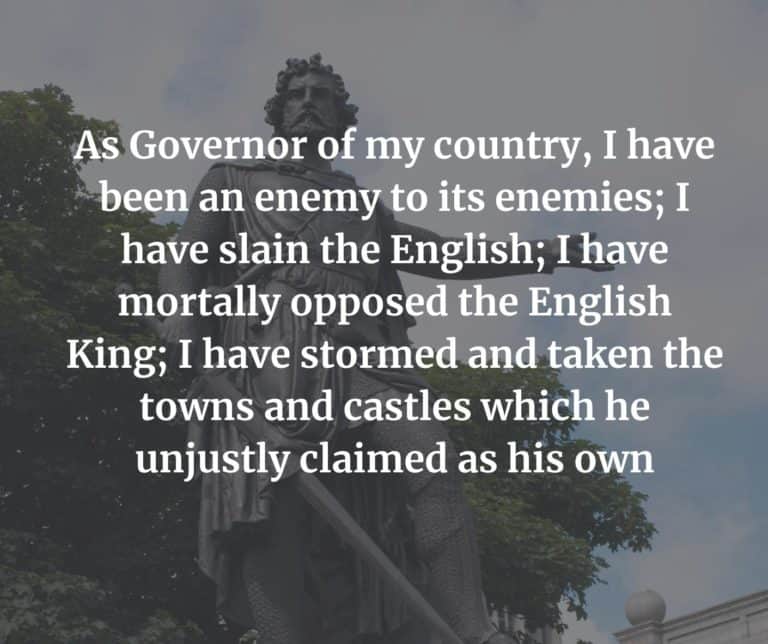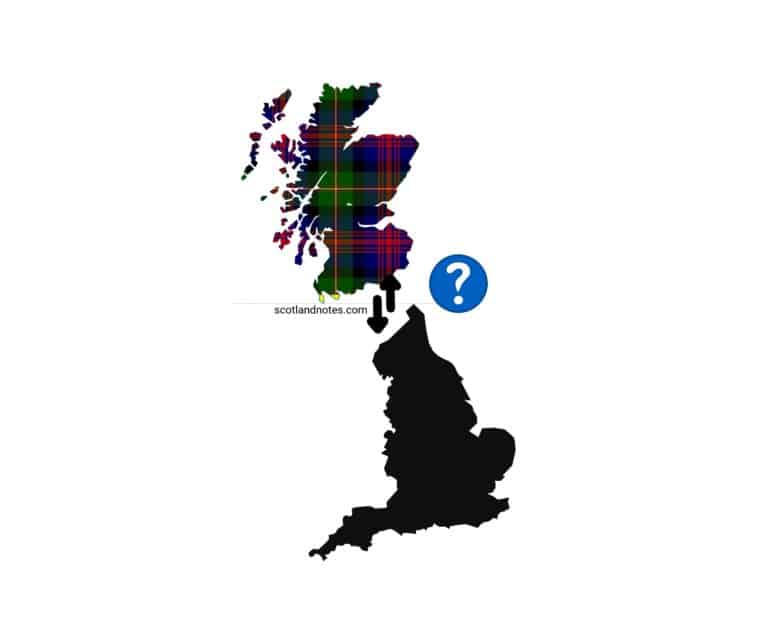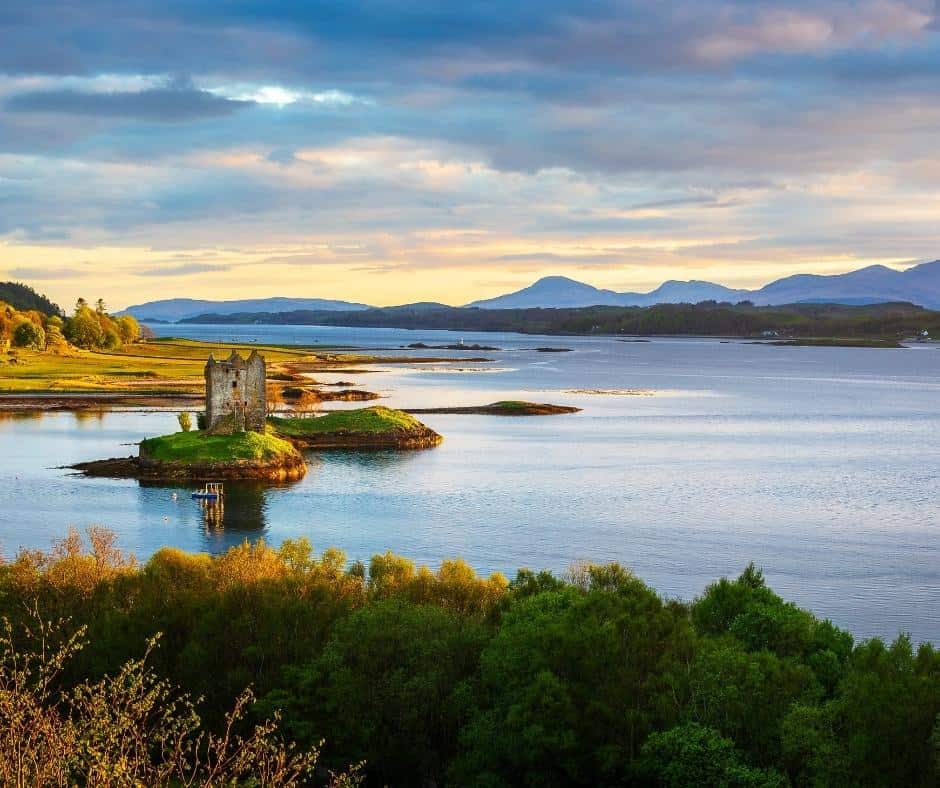
How to Get the Best of Scotland
A visit advisor report on their visit to The Culloden Battlefield site. The site where the Jacobite army and government forces fought their last battle and changed Scotland forever
I went on this tour to a field in Scotland where some people had a fight a long time ago. It was windy and a bit cold
The field had some flags and stuff. One group were called Jack Bites or something, and the other group was led by a duck.
The tour guide kept speaking in a strange language but with some English words.
I think the place was Kuldon or Kull-od-in.
It was a bit boring, and a waste of money don’t go
Yes, it is a false trip report.
But the trip report is correct. It’s identical to the field next to it and the one after that. It is a field with flags and maybe a few cows and sheep.
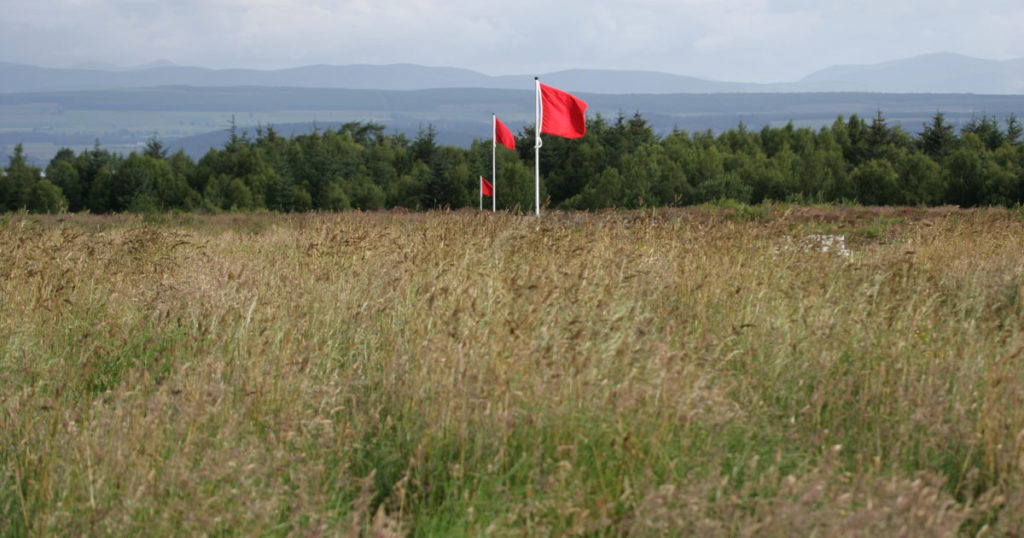
But this handkerchief of Scotland hosted the beginning of the end of a Scottish era.
You can go and see it ———- but to feel it takes a bit more
How to get the best of Scotland
Scotland has so much to offer for all ages and all budgets.
The kid in a candy store was never a more valid analogy, the modern equivalent to FOMO, Fear of Missing Out.
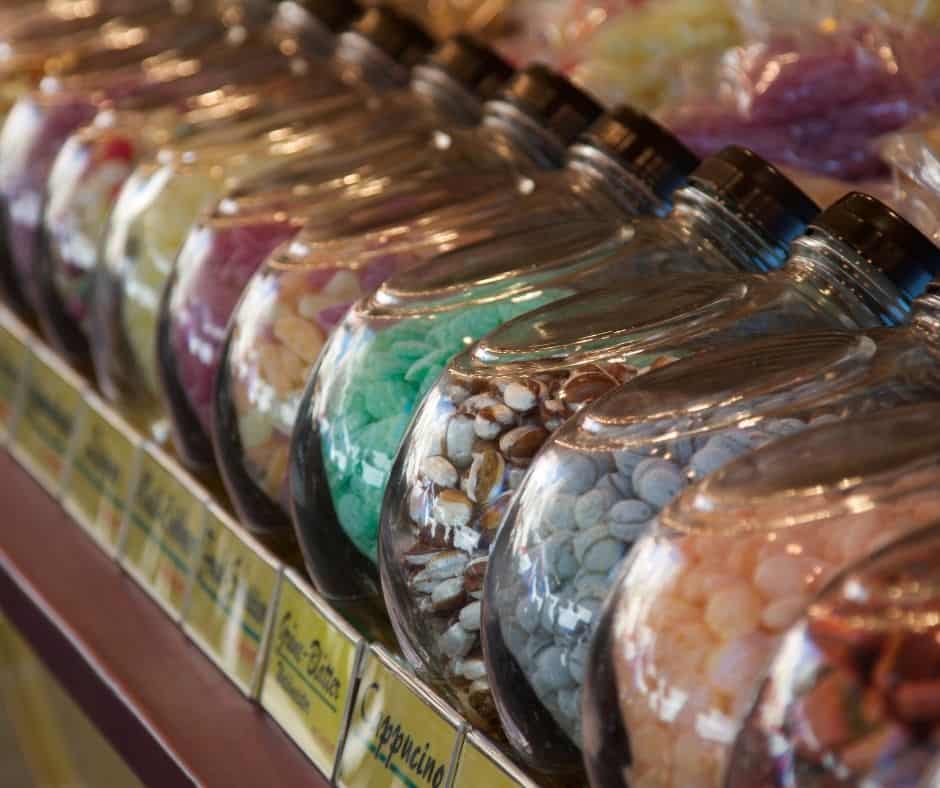
The oversized cartoon menu of experiences has your finger darting over the page. I want that one. No, that one……… look at that; can I have 2?
After the frenzy, it’s time to read the ingredients and cooking method.
You will have limited time in Scotland. Trying to take a bite out of everything will leave you culturally bloated and unsatisfied.
how not to bloat on Scotland/
In my best 1960’s style TV Voice

This is how to Plan Each Day
It usually takes more time than you would think to get from place to place, and factoring in the stops along the way and finding something to eat, you can find yourself dashing between locations.
I have found it best to plan in priority and only 3 things in a day. Should the day go ultra smooth, and you find yourself with more time than you reckoned.
I assure you the time will easily be allocated to experience what you have found on the route to the planned places.
Must – Like – Might
Use the above catchphrase for preparing your trip and each day while in Scotland. You will not go far wrong.
Write down the “Must” for the day, followed by your “Like”, and then jot down one possible 2 “Might.”
Downtime
Also essential is a “Nothing Day”.
Nothing days give you a chance to reorganise your priorities once you have spent some time in Scotland and got a feel for it.
I would advise taking a Nothing day after just a few days and every 5 or 6 days after that if you have an extended stay.
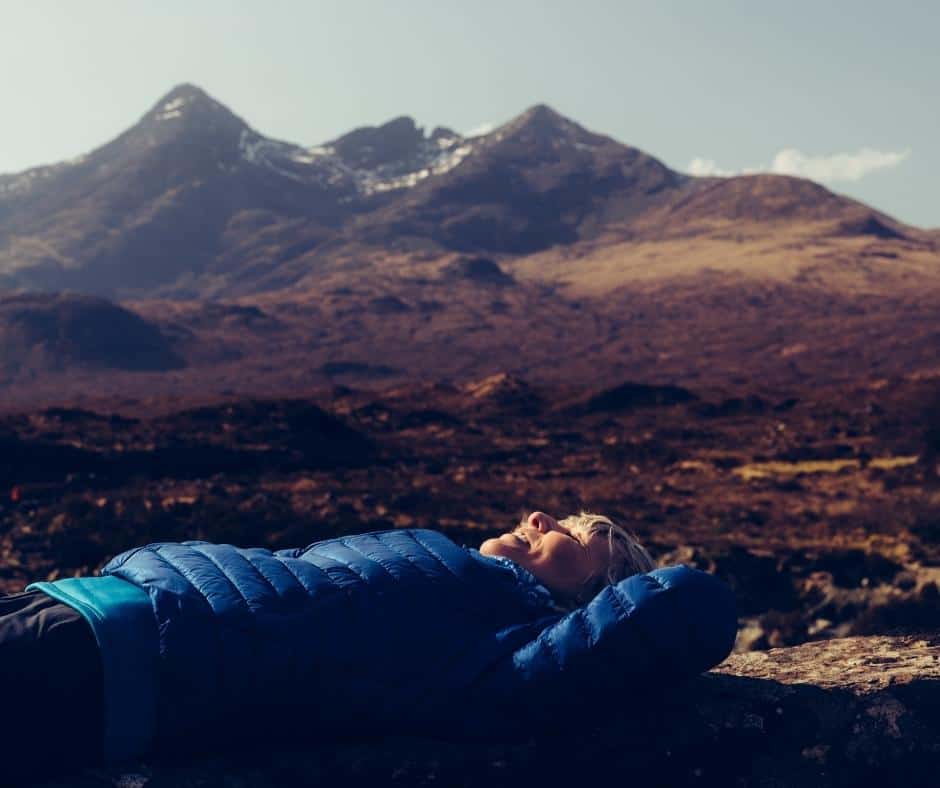
You can have a Single MUST on a nothing day if needed.
Nothing Days are suitable for transferring between your booked accommodation, especially if the travel time is more than 3 hours.
Tight and strict scheduling in Scotland does not work.
Best of Scotland – ultimate tip
I recognise the following advice I am about to offer up might not be for everyone.
The more interest you put into Scotland, the more interest you will get out of Scotland.
Research, Research, Research.
The three laws of enjoying Scotland
I don’t mean the mundane notes of routes and timetables. That’s planning, not research.
I don’t mean the guidebook stuff, dates and people names, and complicated royalty titles.
Duke Archibald De Longname Earl of Whereshire the 5th son of Baron Archbald the Mundane .1234 – 1256
That’s for your history final exam (shudders when thinking back)
“This castle is 1000 years old and was built over ten years by 50 men using mud and animal urine to plaster the walls”, on drones the guide.
It makes me want to jump from the turrets.
That’s what the plaques on the walls and overpriced plagiarised guide books are for.
It is why history never interested me until Willaim Wallace shouted “Freedom” from the silver screen.
How to bring Scottish history alive?
Murder, Mystery Betrayal, Battle and a good dollop of sex. That’s how
Dates and urine-soaked walls are for the tour guides and the plaques and notice boards scattered around.
The Internet – A Scotland Visitors best friend
I agree the internet is not the best resource for doing deep academic research.
But you are not taking a degree. You are a tourist looking to get the best of Scotland.
Scotland is overloaded with behind-the-scenes stories, fables and sometimes almost true tales.
Add the narrative of the history of the place, and you have a fireside and marshmallow night to remember.
Take extra batteries for your under-chin torchlight.
Let’s take a Castle, for example – The Castle will have lots of tales to tell. Become the detective before you arrive and unearth a few plots and mysteries.
As I planned this blog for you, I thought I would give you an example.
I said “Castle” to myself, and myself said “Crathie.” back to me. Much to my surprise, it is not my favourite, but it is close to my village.
I entered “Crathie castle” into the search engine. The typical tourist and encyclopedia sites popped up.
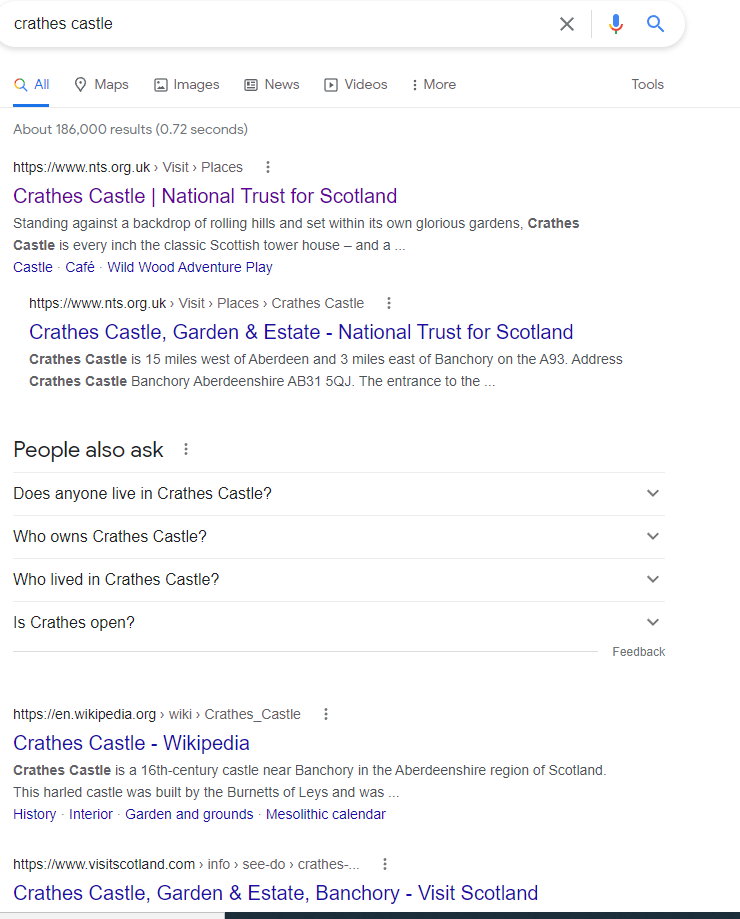
I chose the first one – Take a look
Great site and has some information to help you visit – but shall we say, less than inspiring.
Then I added “tales” to the end of my previous search.
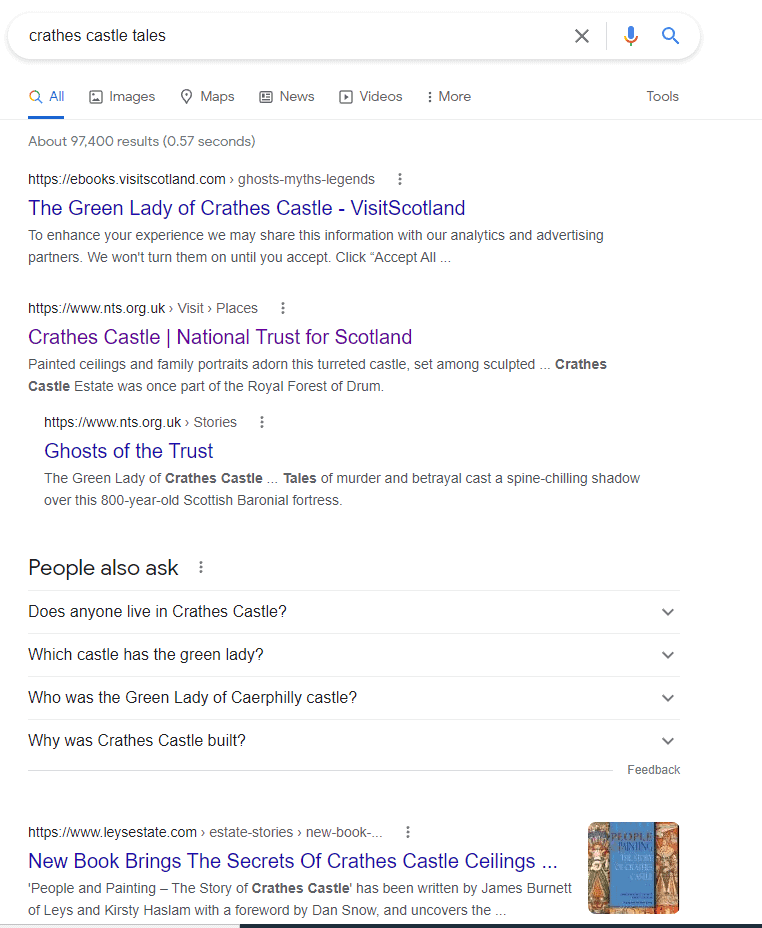
Once again, choosing the first entry revealed
A few words about a green lady ghost:- Ok, but not much to give me the boost I am looking for.
Maybe the tour guide or brochure might even mention it in passing.
One more step
Changing to “Crathes Castle green lady story.”
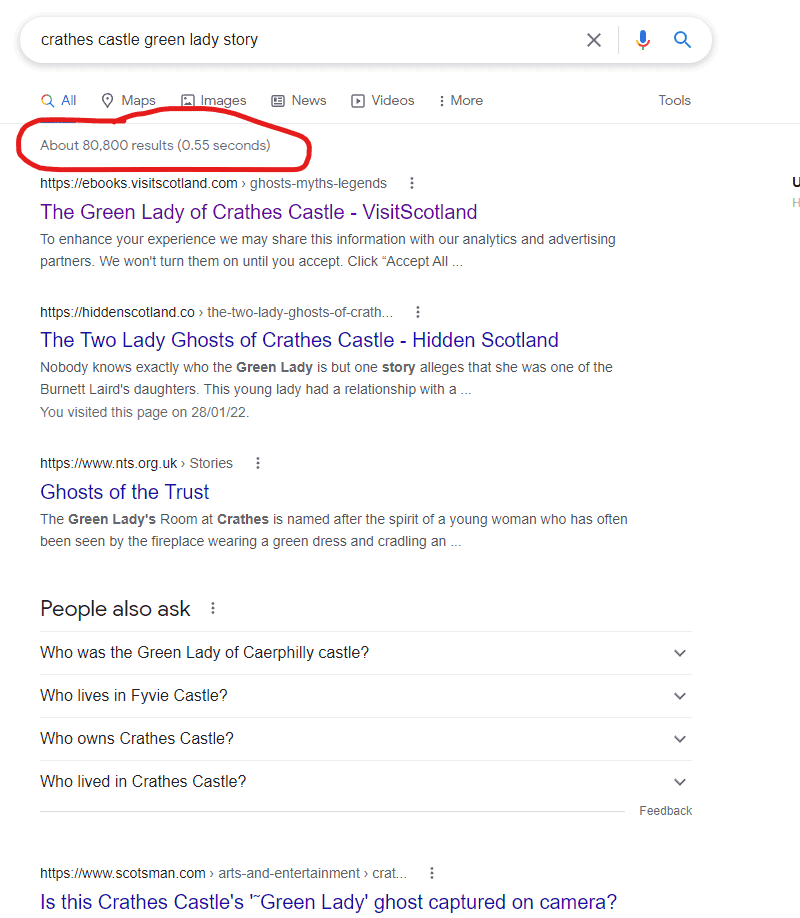
I get 80 Thousand hits. I scrolled down at random (you can check the rest) and clicked this one.
Woe – this is not one for kiddies’ bedtime, but what a story. Please read it to the end.
Then tell me you will not be looking carefully at the fireplaces in the castle.
People will look at you strangely as you take photos of unusual places in the rooms.
That is the trigger to your imagination that shows you how to get the Best out of Scotland.
Not Just Castles
Yes, it will work in all corners of Scotland.
- Rivers
- Bends in Rivers
- Bridges
- Buildings
- Geographical locations
- Hills and Glens
- Islands
- Lochs
- Standing Stones
- Towns, Cities and Villages
No wonder so many world-renowned storytellers originated in the small country of Scotland.
Here are the “A”s
- John Abercrombie (1726–1806), horticulturist and garden writer
- Patrick Abercromby (1665 – c. 1716), historian and physician
- Gilbert Adair (1944–2011), novelist, poet and critic
- Alexander Adam (1741–1809), classicist
- James Adam (1860–1907), classicist
- Jean Adam (1704–1765), poet from the labouring classes
- Marion Adams-Acton (awa Jeanie Hering, 1846–1928), children’s writer and playwright
- Ewart Adamson (1882–1945), screenwriter
- Henry Adamson (1581–1639), historian
- Adomnán (627/8–704), biographer (in Latin), Vita Columbae
- Douglas Ainslie (1865–1948), poet, translator and critic
- Thomas Aird (1802–1876), poet
- Alasdair MacMhaighstir Alasdair (c. 1695–1770), poet
- Gillebríghde Albanach (fl. 1200–1230), poet (in medieval Gaelic)
- William Alexander, 1st Earl of Stirling (c. 1570–1640), poet and dramatist
- Jane Alexander (living), novelist and academic
- Archibald Alison (1757–1839), essayist and Episcopal cleric
- Archibald Alison (1792–1867), historian and advocate
- William Alison (1790–1859), social reformer and physician
- Mea Allan (1909–1982), journalist and novelist
- Adam Anderson (1692/1693–1765), economist
- Alan Orr Anderson (1879–1958), historian
- James Anderson (1662–1728), historian
- James Anderson of Hermiston (1739–1808), economist and farmer
- James Robertson Anderson (1811–1895), playwright and actor
- John Anderson (1726–1796), natural philosopher and reformer
- Lin Anderson (living), crime writer
- Marjorie Ogilvie Anderson (1909–2002), historian
- Patrick Anderson (fl.1618–1635), author and physician
- Andrew of Wyntoun (c. 1350 – c. 1423), poet (in Early Scots), Orygynale Cronykil of Scotland
- Aneirin (fl. c. 575 – c. 600), bard (in Brythonic)
- James Stout Angus (1830–1923), poet (in English and Shetland dialect)
- Marion Angus (1866–1946), poet (in Braid Scots)
- J. K. Annand (1908–1993), poet, best known for his children’s poems
- Alexander Arbuthnot (1538–1583), poet and Church of Scotland minister
- John Arbuthnot (c. 1667–1735), physician, satirist and polymath
- William Archer (1856–1924), critic and translator
- Campbell Armstrong (1944–2013), novelist
- Hugo Arnot (1749–1786), writer and lawyer
- William Arnot (1808–1875), minister and theological writer
- David Ashton (b. 1941), screenwriter, novelist and actor
- Margot Asquith (1864–1945), writer and wit
- William Auld (1924–2006), poet and writer (in Esperanto and English)
- Robert Aytoun (1570–1638), poet
- William Edmonstoune Aytoun (1813–1865), poet, humorist and writer
The incomplete Page from B to Z can be found here
The best of Scotland
Scotland is an exquisitely visual place to visit, but also having Scotland touch you takes a little more work, but with rewarding results.
Let’s look again at the opening when our friend the tourist visited Kil-od-in.
Do you think the review would be as scything if he had read this first
Here is an extract to set the tone
“The battle of Culloden lasted for under an hour. In that time, approximately 1250 Jacobites were dead, almost as many were wounded and 376 were taken prisoner (those who were professional soldiers or who were worth a ransom). The government troops lost 50 men while around 300 were wounded. There is some controversy as to what happened next. The Prince, watching at a distance, was said to be in shock. The orders were given to the Duke’s men that “no quarter shall be given”, and so the slaughter began, 5 miles of blood and bodies as the cavalry finished off wounded men. These orders were not official, though. It seems that someone had inserted the clause to “slaughter all.”
Welcome to the best of Scotland.
Do you have any hints or tips to make your memories lifelong?
Let me know in the comments below, or send me a message through my contact page.
You can also find me on Facebook.

